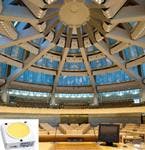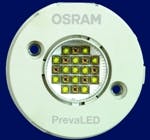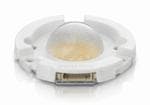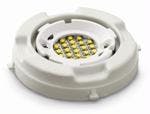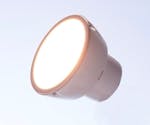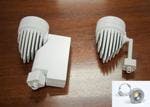This article was published in the November/December 2011 issue of LEDs Magazine.
View the Table of Contents and download the PDF file of the complete November/December 2011 issue.
+++++
Modular LED light engines can allow luminaire makers to develop solid-state-lighting (SSL) products without facing the technical details of electronic driver circuits, LED selection and configuration, thermal management, and optics design. Manufacturers should understand the basics and importance of these product-design disciplines, but a proven module vendor can ensure the details get proper attention. The modular approach can speed product development and enable upgradeable products. Today, the available modules are proprietary to each manufacturer, but standards such as those the Zhaga Consortium has under development will yield interoperable modules from multiple vendors.
Let’s start by defining some terminology for the scope of this article because words such as light engine and module aren’t used consistently in the SSL industry. Zhaga (see www.ledsmagazine.com/features/8/11/4 for background information and an update on Zhaga activity) defines a light engine as the combination of an LED module and its associated control gear or driver.
Zhaga sticks with the term light engine whether or not the driver is integrated into a modular package along with the LEDs. Zhaga is developing specifications for light engines with integrated control gear and light engines with separate control gear. In the latter case the driver is also essentially a packaged module or subsystem.
For this article, we will use the terms LED module and LED light engine interchangeably and simply specify whether a driver is integrated in the module. Indeed the module makers mentioned above use the term module whether or not a driver is included. We will include discussion of modules that fasten into a luminaire using screws or other fasteners, and modules that use some form of snap-in or twist-lock mounting mechanism. The latter are sometimes referred to as tool-less or tool-free designs, and Zhaga uses the term socketable if the module can be installed without tools.
The modular advantage
Modules can offer a number of advantages over what some call integral luminaires where the fixture manufacturer assembles the requisite components including LEDs and the driver ICs that precisely match the application at hand into a finished product. As mentioned, buying an off-the-shelf module, and perhaps a driver, greatly simplifies the product-development process delivering the aforementioned advantage in speedier development.
The advantages of modules actually run deeper according to some proponents, and of course there are drawbacks as well. Bridgelux and Molex were among the first companies to offer a socketable module with the jointly-developed Helieon product introduced last year (http://www.ledsmagazine.com/news/7/3/21). A press-and-turn action locks the Helieon module into a receptacle socket mounted in the luminaire. The mating action both secures the module in place and makes the electrical contact.
Supply chain benefits
According to Posselt, the typical bill of materials for an SSL luminaire is about a third attributable to the LED assembly, a third to the driver, and a third to the remainder of the fixture. Eliminating the need to buy and stock an inventory of components that are needed to build the LED assembly can reduce the investment in inventory significantly.
The tradeoffs
The downside to modules is principally cost. A module may also restrict some of the design elements in a luminaire and therefore the aesthetics. And with modules, luminaire makers will never have complete photometric feature freedom, for instance in terms of choosing an exact lumen output or generating a specific color temperature with a custom LED mix. But the biggest tradeoff comes back to cost. Modules invariably introduce extra materials such as plastic or metal module housings, and complex electrical and mechanical connectors. Moreover the cost of separately assembling the module is an adder.
Module proponents believe that the technology will ramp SSL uptake and the greater manufacturing volumes will reduce the cost premium. Moreover the modular approach will likely resonate with consumers that are accustomed to changing light bulbs rather than replacing fixtures. And that’s Zhaga’s mission to develop specifications that standardize a modular approach to interoperable SSL products rather than having multiple companies building similar but incompatible products.
Menno Treffers, secretary general of the Zhaga Consortium, said “The key thing that we want to achieve is that the products from multiple vendors fit together.” Ultimately Zhaga specifications should allow multiple vendors to make compatible light engines. Luminaire makers will also be able to buy a driver from one company, a mechanical housing from another, an LED module from yet another, and optics such as a reflector from still another.
Zhaga’s process and progress
Zhaga’s approach is based on defining what it calls the mechanical, thermal, electrical, and photometric interfaces of a light engine. The mechanical elements include shape, dimensions and mounting scheme or socket. The electrical interface includes the connector and AC- or DC-voltage specification. The thermal interface defines how cooling elements in the luminaire housing mate to a thermal surface on the module. The photometric interface includes elements such as the size of the light emitting surface, lambertian or shaped-beam pattern, and uniformity of light on the task plane.
The Zhaga process includes proposal, merger, specification-development, and published-specification stages. Members of the consortium that are interested in a particular type of module submit proposals based on their own R&D. Elements of the proposals are merged by task forces and then converted into specifications by working groups.
Zhaga has approved three light engine specifications thus far:
• A socketable LED downlight engine with integrated control gear
• An LED spotlight engine with separate control gear
• A socketable LED light engine with separate control gear.
The specifications have not been made available to the public although members of the consortium have free access. At this time no company can claim official Zhaga compliance for a product because the consortium is still working on compliance testing procedures. Treffers says that the first products to carry the official Zhaga logo are months away from the market as opposed to a year, but he can’t offer a more specific projection.
Zhaga has four other specifications in development including a street light module, and a rectangular module – a number of which may be connected together for indoor linear lighting. There are other proposals at earlier stages of the Zhaga process.
Designed for Zhaga
In reality, there are already modules on the market that are based on Zhaga standards, or more correctly that were the basis for a couple of the completed Zhaga specifications. Remember that Zhaga’s process is based on merging proposals from multiple companies. When asked if individual companies were behind any of the Zhaga specifications, Treffers said, “In all cases there were multiple companies involved.” Still it’s pretty clear that in some cases a single company has provided the majority of the technical input.
Given the clear tie between Infusion and one of Zhaga’s completed specifications, we asked Steve Briggs, vice president of marketing and product management at GE Lighting Solutions (the LED-focused business within GE Lighting) about the collaboration in the Zhaga process. Briggs said that multiple companies were involved in proposing concepts and added “Our Infusion module has been shaped and changed by the Zhaga process.”
As an example Briggs pointed out a design change that happened between the announcement of the second-generation Infusion back at Lightfair in May and the production modules that just commenced shipping in Q3. The mechanical design now includes mechanical mounting tabs on the front of the module that allow easy connection of reflectors or other optics.
So in some cases the multiple parties that participate in the Zhaga proposal-merger process may have interest in different elements of a luminaire design as opposed to being companies with competing module concepts. For example, Posselt said that while Bridgelux is a Zhaga member, that the company’s primary goal in the endeavor is to “make sure our core product, the LED array, is not precluded from use in Zhaga-compliant products.”
Too many or just right?
The question that arises with the Zhaga progress to date is one of how many standards do we need. In lighting, there are clearly different requirements for modules in different applications. For example street lights will need larger modules with space for more LEDs. Downlights and spot lights will need small circular modules and linear fixtures long and slim modules. Still it’s already evident that Zhaga will publish specifications that overlap and that may be bad for an industry looking for standardization to ramp production volumes of interchangeable products.
The opposite pull of the desire for standardization and the need for optimum luminaire design for a specific application is a tough conundrum. Companies have vastly different philosophies and that is surely playing out within Zhaga. To understand the philosophical extremes, let’s take a closer look at the existing module products available from GE and Philips.
Philips’ approach is a module for every application or maybe more than one. Andrew Lindstrom, director of SSL at Philips Lighting, said, “We have competing lines across the board.” Consider street lighting where we have published numerous stories about applications that use Philips’ LED-gine module. That module uses LEDs in an array with TIR (total internal reflection) optics on each LED to form a beam.
Philips also offers the Fortimo LLM (linear light module) that is based on remote-phosphor technology and that targets outdoor applications with output ranging from 1100-4500 lm. And the company has the Fortimo HBM (high brightness module) that uses phosphor-converted LEDs and delivers 4000-6000 lm, and that Philips business development manager Dan Sullivan said is designed to be compatible with a Zhaga standard currently under development.
In the indoor space the Philips line is equally if not more crowded. The Fortimo DLM (down light module) uses remote phosphor technology. Philips’ Sullivan said in a recent presentation that the remote-phosphor approach could provide a 30-40% efficiency advantage. Philips’ Lindstrom adds that the remote phosphor provides more consistent color and said “For the near term, 12-18 months, remote phosphor is definitely going to be the way to go.”
It’s worth noting that Zhaga doesn’t weigh in on the choice of remote phosphor or direct lighting using phosphor converted LEDs. Either is allowed although some mechanical designs may lack the depth and size for an efficient mixing chamber needed for the remote approach.
Moreover some applications aren’t compatible with remote phosphor even if it does offer an efficiency advantage. Philips for instance, uses phosphor-converted LEDs in the aforementioned Fortimo SLM. Lindstrom said the need for a tight beam pattern dictated the choice.
One module, many uses
GE, conversely is planning to use Infusion across applications. That usage certainly won’t include street lights. Briggs said that the company is investigating linear modules for such applications. But Infusion will span downlights, spot lights and many other indoor products. GE has announced Infusion modules ranging in output from 850-3500 lm and plans to go to 5000 lm.
Briggs said that luminaire makers will be able to choose a module with an LED package that’s optimum for any specific application. They will add an optics package that’s matched to the LED package and application. GE already has a broad portfolio of optics and third parties will offer products as well.
The migration to modules is in the early stages. It’s too soon to know if modules will become the dominant choice for SSL implementations or remain a niche. Much may depend on how well Zhaga is accepted. Even if Zhaga yields overlapping specifications, the standardization effort does accomplish something else – it opens technology developed within companies to others. No one has rights to the intellectual property within a GE Infusion module, for example, but others can build compatible products once Zhaga publishes the specification.
And modules are being successfully – and spectacularly – deployed today. Our cover photo for this issue, and another nearby photo, are of the Dusseldorf parliament hall lit by Hoffmeister Leuchten LED downlights that are based on 2000-lm Philips Fortimo DLM modules

